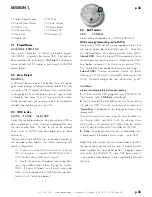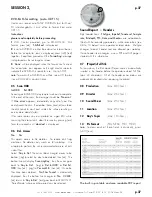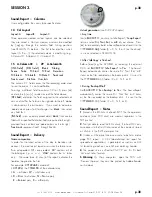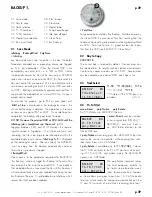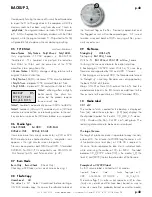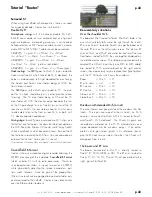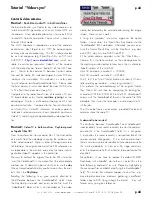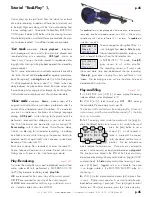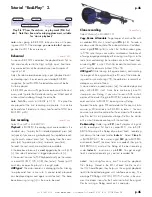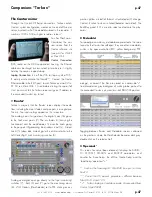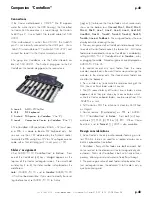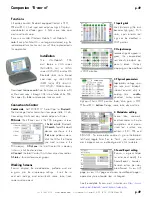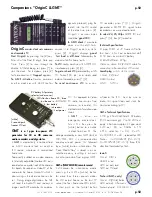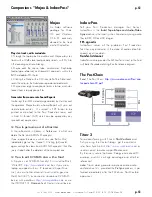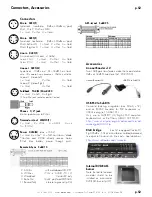
+33 4 7642 9550
www.aaton.com
User manual for Cantar-X1 & X2 v2.15 2008 March 28
p.50
p.50
OriginC
master-clock sets cameras
and recorders TC
Start OriginC
by pressing the [#] key.
Enter
all of
the Prod ID digits, Date and
Time. Press [#] to scan through the
display. All fields being set, press [*] to
start the clock. To shut-down, press [#]
for five seconds until ‘
Stopped
’ appears.
To ASCII initialize
Cantar, cameras
or other machines with ASCII (an fps
agnostic protocol), plug the
Lemo 5 into the LTC socket
of the machine, press [#].
OriginC’s answer back
should be '
good 00.0
'.
To ASCII check
if a camera
clock is within drift limits,
connect it to OriginC once in a while,
press [#]. OriginC displays ‘
good
’
‘
fair
’ ‘
bad
’ or ‘
diff-time
’, followed by the
amount of drift in frame tenths.
To LTC init
a machine with SMPTE LTC,
simultaneously press [#] [0].
To get or check LTC
generated by a IVS-
TC, Fostex PD6, etc. or to simply read
external timecode, press [*] [2].
To send continuous LTC
to a non-
TC recorder, press [*] [1], OriginC
generates a SMPTE LTC signal to be
recorded on an unused audio track.
To select 24, 25, 30fps
SMPTE LTC out,
press [*] [4], then [#] to confirm.
Technical Specifications
•1 ppm TCXO ±1/2 frame shift after
four hours •Six hour automatic-shutoff
•150 hours on a Li-Ion 9V battery.
•180x90x20mm. 375gr.
Order an Aaton L5-XLR3-SCH cable for
connection to the recorder's LTC socket.
Lemo 5 plug
(ref: PHG OB-305-CLLD42)
1-Gnd 2-LTC out
3-ASCII in/out
4-NC 5-LTC in
Companions "OriginC & GMT"
GMT
is a 1 ppm low-power LTC
generator for SD or HD cameras,
audio recorders and digi-slates.
•
GMT
is momentarily initialized from
an ASCII master-clock or another
LTC source, whatever its normalized
frame-rate.
Permanently installed on a video camera,
its (internally adjustable) line-level LTC-out is
recorded on an audio track of the camera;
this bonds the record-run Video-TC of the
camera to the free-run Audio-TC which is
also running in the other machines on the
set. During image digitization, the NLE
will read the Audio-TC and «autosync»
images and BWF audio by this common
TC. As opposed to Video-
TC radio transmission from
camera to recorder, this
method works for multicamera
shoots.
•
G M T
i s a l s o a n
emergency master-clock.
Turn it ‘On’ then press the
[white] button to initialize
its clock from hour 01. The
date generated by a new GMT starts at
Y92/M01/D01, it is incremented by
one day at each power ‘On’ followed
by a [white] button initialization. The
“Year/Month/Day” is stored in a non-
volatile memory, resulting in a
never-
twice-the-same date
from a given GMT.
GMT-u (NEW MODEL) remote record
• Whatever the initialization mode,
pressing the GMT-u [white] button
for more than three seconds makes
the LTC output freeze on the last TC
value (the four frame-rate LEDs blink).
A short push on the [white] button
unfreezes the LTC. Sent by wire or
radio, this signal stops and starts the
Cantar recording (p.19).
GMT-u Technical Specifications
• 150 gr • 63x123x26mm • 9V battery
(150 hours working) • 7 to 18 VDC ext.
supply • 6mA consumption • 1 ppm clock
• LTC-out: -20 to -60dBu & TTL
• FPS selector: 1 = 24, 2 = 25,
3 = 29.97 DF, 4 = 30 ; selected fps LED
flashes.
5 = 23.98NDF [24
–
0.1%],
6 = 29.97NDF [30
–
0.1%]; three LEDs,
other than the selected fps, flash.
Lemo
5
1-Gnd 2-LTC in
3-ASCII in/out
4-LTC out, adj. level
5-LTC out, TTL level
Fischer
4 (GMT-u only)
1-Gnd 2-[White] button
3-LTC out adj. 4-Power in
(Fischer 4 plug ref: S102A053130
LEDs flash on frame 00; ‘three
but the one’ in – 0.1%
NTSC
[white]
3 second push
freezes LTC-out
9V battery & fps rotary
selector (under cover)
• low battery
• init request
• ext power

